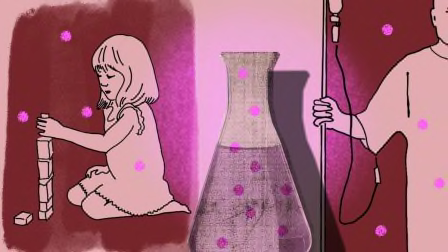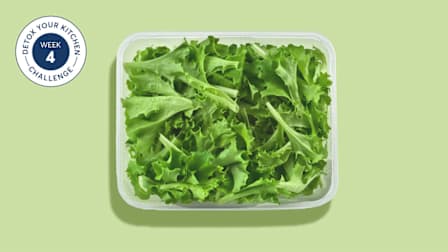A Major Source of Toxic PFAS Has Been Eliminated, FDA Says
Manufacturers have stopped selling grease-proof food packaging coatings that contains the harmful chemicals. It's a key step, but it's not the end of PFAS.

Pretty much all of us are exposed to the “forever chemicals” known as PFAS (per- and polyfluoroalkyl substances), which are often used to make products grease-proof, waterproof, nonstick, or stain-resistant. But soon Americans will be exposed to far lower levels of those chemicals from food packaging, which has been a significant source.
That’s because manufacturers have now stopped selling grease-proof food packaging coatings that contain PFAS, the Food and Drug Administration announced Feb. 28. Food packaging is the food contact material that’s most likely to result in PFAS migrating into food and getting into people, according to the FDA.
“This represents a positive step,” says Brian Ronholm, director of food policy for Consumer Reports.
For decades, various PFAS have been added to products like popcorn bags, fast-food wrappers, and paperboard containers. But a growing body of research has shown that these chemicals are associated with a number of health harms. And there has been a movement to end unnecessary uses of PFAS, such as in food packaging. A total of 12 states, including California and New York, have already banned PFAS in food packaging.
In recent years, Consumer Reports has tested for PFAS in food packaging, as well as in nonstick cookware and tap water. In 2022, we tested more than 100 food wrappers and containers from fast-food restaurants, fast casual restaurants, and grocery stores, and found many with high levels of PFAS. (After CR’s testing, several restaurants, including Burger King and Chick-fil-A, announced plans to stop using PFAS in packaging.)
How We Got Here
In 2016, the FDA revoked the authorization that allowed manufacturers to use certain PFAS—in particular PFOA and PFOS—in food packaging, based on evidence that these compounds posed significant hazards to human health. (See our article on the health hazards posed by PFAS.) By then, manufacturers had already stopped using these compounds to create grease-proof coatings for packaging, and had moved on to newer PFAS compounds.
In the following years, FDA researchers published a number of papers indicating that—as with the previously phased-out compounds—one of the primary replacement PFAS, 6:2 FTOH, was concerning as well. They found it could stick around in the body for long periods of time and was associated with significant health risks.
In 2020, the agency convinced manufacturers to agree to voluntarily phase this compound out of grease-proofing substances intended for food packaging. The FDA’s February announcement says that this voluntary phase-out is complete. It may take until June 2025 for existing product stocks made with these compounds to be exhausted, according to the FDA. But since some of the companies that sold these coatings made these changes sooner than required by the agreement, the agency believes that many of these products have already been phased out, according to an FDA official.
In addition to the voluntary phase-out, the FDA says that PFAS manufacturers have stopped selling all other authorized grease-proofing substances containing PFAS.
“This ‘win’ for public health is the result of FDA research and leadership, combined with cooperation from industry,” Jim Jones, deputy commissioner for human foods at the FDA, said in a statement.
Still, the agency has not yet said whether it will revoke the authorization to use all PFAS in grease-proofing substances and in food packaging materials in general. The FDA Is currently in the process of amending the regulations that allow it to revoke the authorization to use certain food contact materials in a way that would give the agency more flexibility to do so when needed, according to an FDA official.
While food safety advocates are encouraged by this development, some say it should have happened sooner. “It is amazing how long PFAS manufacturers have continued to profit from wrapping food with these toxic chemicals while knowing about the harm caused by exposure,” David Andrews, PhD, a senior scientist at the Environmental Working Group, said in a statement.
And Ronholm, at CR, says there is still lots more to do. “From a consumer standpoint,” he says, “it would be more reassuring if they took steps to ban the use of all PFAS in food packaging.”
We’re Still Exposed to PFAS
While reducing exposure to PFAS from food packaging is a welcome step, experts say there’s still a long way to go.
“This will eliminate another route of exposure to PFAS,” says Ned Calonge, MD, associate dean of public health practice at the Colorado School of Public Health. In 2022, when the National Academies of Sciences, Engineering, and Medicine conducted a review and issued guidance on PFAS exposure and testing, they didn’t find much evidence on how important this particular exposure route was to the average person’s blood levels of PFAS, according to Calonge, who chaired the committee. “Still, eliminating any route of exposure is important.”
There are plenty of other sources of exposure that need to be addressed. These include water supplies: A 2021 investigation by CR and The Guardian looking at water samples from around the U.S. found PFAS in 117 out of 120 samples tested, with 35 percent of samples testing over a threshold that many health experts and CR believe should be the safety limit for PFAS in water. Water is an even bigger concern in communities such as the hundreds of military bases where water supplies have been contaminated by certain types of firefighting foam.
What’s more, many consumer products still contain PFAS, including nonstick cookware, various cosmetics, and waterproof or water-resistant furniture, clothing, and carpets.
The production, use, and disposal of all these products mean PFAS are still routinely released into the environment, where they don’t break down but accumulate, potentially causing further contamination.
Because of the ubiquity of these compounds, they are hard to avoid. But it is possible to limit exposure by avoiding certain types of products, treating your drinking water, and avoiding PFAS-laden dust. Read more about how to limit your exposure to PFAS.
@consumerreports In a step in the right direction, the Food and Drug Administration announced that manufacturers have now stopped selling grease-proof food packaging coatings that contain PFAS. Still, there’s more work to do. Learn more through the link in our bio. #foodtok #pfas #foodsafety #foreverchemicals
♬ original sound - Consumer Reports




















